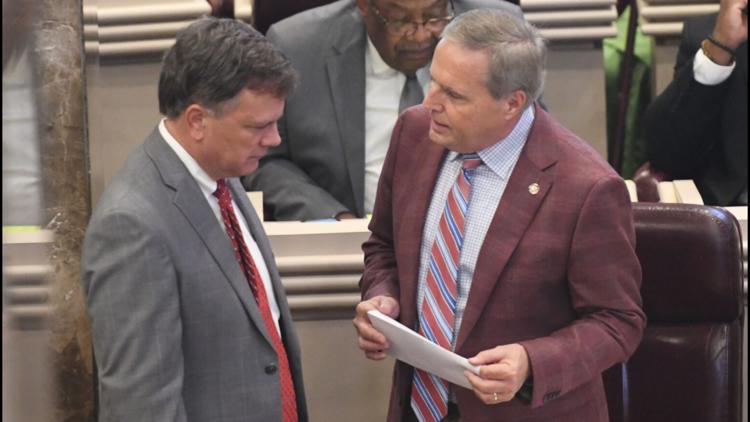MONTGOMERY, Ala. — Alabama lawmakers set out guidelines for developing a new funding formula for public education in the state at a meeting Thursday.
The Legislative Study Commission on Modernizing K-12 School Education Funding had a second meeting to learn more about a weighted student funding model, part of conversations about whether to adopt a new funding model.
Rep. Danny Garrett, R-Trussville, the chair of the House Ways and Means Education Committee, laid out “basic assumptions” on a slide in determining a new model: “1) Funding aligns with student needs;” “2) All districts will see increased per-pupil funding;” “3) School systems will receive more flexibility in allocating the funding they receive through the state’s funding formula;” and “4) Systems will retain control over local funding. Local dollars will not shift from one district to another.”
“This is a good faith effort to try to understand what other states are doing, to see if after 30 years of the current education funding model, we need to take a different approach and modify what we do,” said Garrett. “We’ve communicated there’s no decisions have been made. There’s no preconceived ideas.”
Alabama’s current system is a hybrid-foundation model, which allocates resources based on a formula of students and faculty. The funding is tied more to a headcount than the needs of students, while the costs of individual students can vary based on need.
Alabama is in a minority of states that still uses that model, compared to a student-weighted funding model, which aims to allocate money based on need. At the first meeting, Garrett said that a lot has changed in the 30 years since the current model was adopted, and they are looking at options.
Sen. Arthur Orr, R-Decatur, the chair of the Senate Finance and Taxation Education Committee, told reporters after the meeting that they would not be moving local funds around.
“That money would remain with the locals to determine how they spend it,” he said.
Asked if that meant that some districts could be seeing smaller amounts of state funding allocated if a new model is adopted, Orr said it was too early in the process to say.
“We’d have to see because the economy is growing, we’ve got larger reserves and so it’s premature to say something,” he said.
Alabama’s constitution limits local governments’ ability to tax, and a series of amendments passed in the 1970s known as the Lid Bills capped assessments of properties, particularly for homes and farms. County governments, particularly in rural areas, often struggle to raise adequate revenue for education.
Jennifer Schiess, senior partner and practice lead for policy and evaluation at Bellwether, an education nonprofit, said in a presentation to lawmakers that the state’s current funding model was inflexible.
“Resource based formulas like Alabama’s really center funding conversations on inputs and that kind of specifies a particular mix of personnel choices, a particular mix of instructional choices that essentially is a template, a one size fits all approach for all districts, and doesn’t really enable districts to make choices based on their individual student populations,” she said.
Scheiss presented four takeaways from her presentation: Alabama’s foundation program hasn’t kept up with inflation and doesn’t address student needs; more investment in education leads to better outcomes; student weight-funding formulas address adequacy, student needs, accountability and transparency better than other models; and other state examples can inform a potential new Alabama one.
“We’re seeing stronger outcomes tied to increased funding,” she said. “So it’s just something to think about as you think about sort of the future workforce, these as a state as well, and that’s part of what this investment is buying.”
Alex Spurrier, associate partner with Bellwether, told lawmakers that different states have different models.
Student weights can be attached to items like English as a second language or special education that would lead to more money being allocated to the school system.
Tennessee, Spurrier said, has 10 different tiers for weights, ranging from 15% for special education consultation services to 150% for homebound, hospitalized or residential services.
Lawmakers asked the Bellwether representatives questions throughout the process, with Orr asking questions about the use of money, such as spending money on sports rather than academics, or a gaming of weights. He also asked about accountability for achievement.
Orr told reporters after that it was important to him that they don’t give districts more money and get the same outputs.
“If the expectation is that your student population requires additional funding to improve their outputs or their academic standard or the academic achievements, then we are going to have that expectation if we give you these extra dollars,” he said.
Orr said that he didn’t think they would “not rip the band aid off” like Tennessee and Mississippi and that it would be more a long term process. He said they wanted to lay out the facts for the committee.
He said that details about filling funding gaps would come if the Legislature decides it’s something they want to pursue.
“Then it’s up to the consultants to bring various models for us to look at and then see what we’re interested in going forward,” he said. “So we’ve not looked at those models yet.”
The committee plans to meet again in October.
This article originally appeared in the Alabama Reflector, an independent, nonprofit news outlet. It appears on FOX54.com under Creative Commons license CC BY-NC-ND 4.0.



